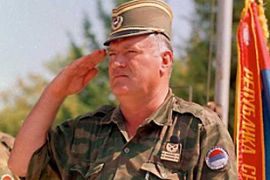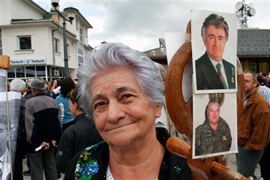Profile: Ratko Mladic
Former army chief of Republika Srpska during Bosnian war is wanted for genocide by UN.

During his time as chief of staff of the army of Republika Srpska, Mladic is also charged with the killing, deportation and forcible transfer of non-Serbs in support of “ethnic cleansing” campaigns in Bosnia in 1992 and 1993.
Srebrenica massacre
The Srebrenica massacre is seen as the single worst atrocity in Europe since World War II.
 |
| Mladic, like Karadzic, has been indicted for genocide [AFP] |
In the five days after Bosnian Serb forces took control of Srebrenica, at least 8,000 Muslim men and boys from age 12 to 77 were murdered, after they were separated out for “interrogation for suspected war crimes” by the Serbs.
Mladic is accused of involvement in the torture, abuse, sexual violence and beatings of Bosnian Muslims, and of creating conditions in detention facilities “calculated to bring about the physical destruction of Bosnian Muslims”.
He also faces charges over attempts to conceal the executions of Bosnian Muslims in Srebrenica by reburying, in isolated locations, bodies exhumed from mass graves.
The indictment alleges that Mladic “was a member of a joint criminal enterprise whose objective was the elimination or permanent removal of Bosnian Muslim, Bosnian Croat, or other non-Serb inhabitants from large areas of (Bosnia and Herzegovina)”.
Military commander
Mladic was born in the village of Kalinovik, in Bosnia, in 1942.
He was brought up in Yugoslavia, during the rule of Josip Broz Tito, becoming an officer in the Yugoslav People’s Army.
As the country began to fall apart in 1991, he was posted to lead the Yugoslav army’s 9th Corps against Croatian forces at Knin.
Later, he took command of the Yugoslav army’s second military district, based in Sarajevo.
In May 1992, the Bosnian Serb assembly voted to create a Bosnian Serb army, appointing Mladic to the post of commander.
Mladic led Bosnian Serb troops throughout the 1992-1995 conflict.
At the end of the war, Mladic returned to Belgrade, where he went into hiding.
 |
| Mladic led Bosnian Serb troops in the 1992-1995 war [AFP] |
The ICTY has said on several occasions that he is still in hiding in Serbia.
Milosevic protection
It is believed Mladic lived in or near the Serbian capital, under the protection of Slobodan Milosevic, the former Serbian president, until Milosevic’s arrest in 2001.
In 2004, it was reported that Mladic was being aided by Bosnian Serb military forces.
Serbia has persistently denied knowledge of Mladic’s whereabouts, although it recently admitted he had been under military protection until mid-2002, and received a pension from Belgrade until last December.
Speculation mounted that Mladic would soon be arrested when Karadzic was arrested in Belgrade in July 2008.
The US government has offered a $5m reward for information leading to his arrest.
Both Nato and the EU have said Mladic must be caught before Serbia can join their respective organisations.
In a speech this year, Jaap de Hoop Scheffer, the Nato secretary general, said: “See that Mladic gets to The Hague, and I can tell you that Nato will bring you in very quickly, then you can continue stabilisation and association with the European Union.”